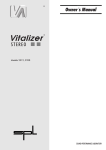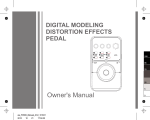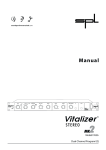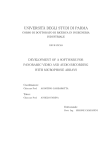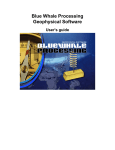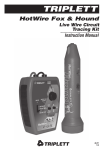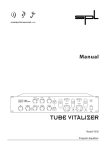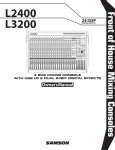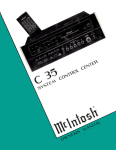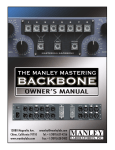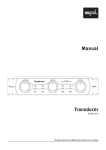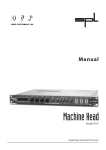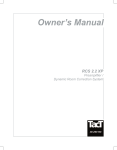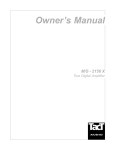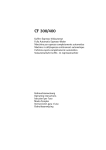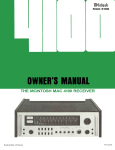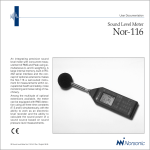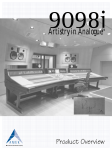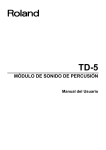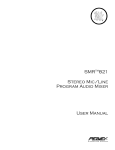Download Sound Performance Lab EQ MAGIX User's Manual
Transcript
Owner´s Manual SOUND PERFORMANCE LABORATORY SOUND PERFORMANCE LABORATORY EQ MAGIX Owner´s Manual by Hermann Gier Manual version 2.1/94 The information in this document has been carefully checked and is assumed to be correct. However Sound Performance Laboratory (SPL electronics GmbH) reserves the right to modify the product described in this manual at any time. This document is the property of SPL electronics GmbH and may not be copied or reproduced in any manner, in part or full without the authorization of SPL electronics GmbH. Construction and circuit layout are subject to constant improvement and development. Changes will be made without notice. © 1994 SPL electronics GmbH All rights reserved ® 1993 Vitalizer is a registered trademark of SPL electronics GmbH Sohlweg 55 D-41372 Niederkrüchten Germany Tel. (0 21 63) 98 34-0 Fax (0 21 63) 98 34-20 SPL electronics GmbH Foreword Introduction 4 4 The concept of sound processing in the EQ MAGIX 7 Installation Inputs & outputs Power supply Rear panel Connection examples 9 9 10 11 11 Control elements Input Mic /Line Line -30dB Peak Phase reverse 48V phantom power supply Insert 12 12 13 13 13 14 Parametric Active Frequency Boost/Cut (+/-) Bandwidth Q Q Fine Notch Deleting an interference frequeny Introduction into the Vitalizer The control elements of the Vitalizer Active +10dB Peak Bass Deep Mid-Hi Tune Process Harmonics Combine Output Pan PPM Meter Fader Mute Contents 15 15 16 17 17 17 19 20 22 22 22 23 24 24 25 26 26 27 27 27 27 Specifications Block diagram Circuit layout Main board & top board 28 29 30 32 EQ MAGIX legend 33 Warranty 34 3 Foreword Dear customer, Thank you for the confidence you have shown towards SPL electronics GmbH by purchasing the SPL EQ MAGIX. The EQ MAGIX is a first-rate Equalizer with exemplary specifications, excellent workmanship and unrivalled sound quality. Please study this owner´s manual carefully so that you can make the most of the wide range of possible applications offered by the EQ MAGIX and to ensure ease of operation. We have tried to write this manual in such a way that it is easy to understand, with as clear a layout as the complexity of such a sophisticated product allows. The manual is divided into two columns throughout. The main column contains a detailed description whilst the margin contains headings and summarized information. We wish you every success and unlimited enjoyment with your new EQ MAGIX. SOUND PERFORMANCE LABORATORY SPL electronics GmbH Introduction The EQ MAGIX is a single-channel equalizer system consisting of a parametric and a psychoacoustic equalizer. Both are combined with a superior microphone preamplifier and an active two-channel panorama output stage. People in MIDI hybrid studios or production studios often need a single mixing desk channel with superior microphone preamplification and perfect sound control to record different song tracks, saxophone or guitar soli on R-Dat, hard disk or samplers. The EQ MAGIX is, so to speak, an »all-in-one« tool for applications of this nature. The EQ MAGIX is ideally suited for both a demanding instrumentalist's or a singer's rack. Existing equipment can be looped into the signal path via INSERT. The unit's outputs are either connected directly with the recording medium or with one to four (2x balanced and 2x unbalanced) mixing desk channels. From there, the signal is fed into the Insert Return after the EQ section (provided that appropriate Insert points are available), so as to bypass as much desk circuitry as possible. As you know, a signal is also influenced if all the switches are on »off« and all controls are in the centre position or on »0«. That is why it is advisable to feed the signal in after the desk equalizer. The technology in the microphone preamplifier is used in the very latest generation of mixing desks made by Harrison and SSL. The PARAMETRIC 4 Introduction equalizer of the EQ MAGIX is based on SVF design (state-variable-filter) and provides a operation frequency range between 14 Hz and 58 kHz. The integrated VITALIZER was developed by SPL and has achieved a significant degree of popularity over the years. The filter concept works on the basis of psychoacoustic sound principles and is therefore ideal to achieve creative sound effects. The combination of a flexible parametric EQ and VITALIZER means that the EQ MAGIX is not only predestined to process the sounds of acoustic instruments but also to post-process samples or poor quality Sync audio tracks, ranging from the elimination of aliasing artefacts or other digital interferences to the addition of sub basses or comprehensive sound improvements via the VITALIZER. The EQ MAGIX provides you with equalizer technology which is unrivalled in comparable units. You will find that this equalizer can not only be set quickly and accurately at the desired frequencies but, with the aid of loudness sound control, can also form sound patterns which cannot be achieved with conventional equalizers. The section below contains a brief description of the EQ MAGIX's function groups: 1. INPUT: Microphone and line level signals can be preamplified in the INPUT section. Microphone signals can be preamplified up to 65 dB. Activating the LINE switch attenuates the preamplifiers stage by -30 dB. There is a phantom power supply (48 V) for condensor microphones. The PHASE REVERSE switch is used to change the polarity of the microphone. The PEAK LED provides adequate warning of potential overdriving of the output stages in the INPUT section. 2. INSERT: Additional sound processing equipment such as a compressor, de-esser or reverb can be looped into the EQ MAGIX via the INSERT jacks. The INPUT section can be used separately for one signal, whilst the equalizer sections are available for a second signal. Use the INSERT SEND as the output for the INPUT section and the INSERT RETURN as the input for the second signal. 3. PARAMETRIC: The PARAMETRIC equalizer is to boost or cut different frequencies or to cut out specific interference noise signals. It is, in a manner of speaking, a corrective instrument in the EQ MAGIX chain of sound-processing tools. The PARAMETRIC works according to the constant-Q principle. The frequency ranges between 14 Hz and 58 kHz. The control characteristics of the bandwidth (Q) control ranges from Q0.6 to Q3.6 and can be sensitized via the Q-FINE switch to set more subtle Q values. The boost or cut range is max. +/-15dB. The integrated NOTCH filter can be controlled in frequency, bandwidth and also in the filter slope (ROLL-OFF) from gentle decreasing or increasing (GENTLE) to steeply decreasing or increasing (STEEP). This significantly increases the tonal flexibility of the NOTCH Filter. The INPUT section features a microphone preamplifier with 48V phantom power supply, PHASE REVERSE and LINE -30 dB switch, PEAK indicator INSERT jacks between microphone preamplifier and PARAMETRIC equalizer. PARAMETRIC equalizer with a frequency range from 14 Hz to 58 kHz, constant-Q, Q-FINE switch, +/-15dB BOOST/CUT, NOTCH with ROLL-OFF 5 Introduction The VITALIZER® in the EQ MAGIX: The new generation of psychoacoustic equalizers for the first time in a 19“ mixer channel module, together with microphone preamplifier, PARAMETRIC equalizer and PANORAMA output stage. The PANORAMA output stage creates a double Mono output signal from the Mono input signal and enables active panning between the two channels. Two LED meters indicate the PPM peak values. MUTE and FADER switch options. 6 4. VITALIZER®: The VITALIZER is an equalizer concept which makes use of scientific psychoacoustic technology to process audio signals. The unique combination of dynamic equalizers, amplitude-controlled phase correction and harmonic filtering in the VITALIZER opens up a whole new listening dimension by adapting the sound pattern to the non-linearities of the human ear. The VITALIZER is thus the creative element amongst the EQ MAGIX's sound processing tools. The VITALIZER gives the mid frequencies accurate transparency with a soft, unobtrusive sound. The treble and harmonics range is reworked with broadband shelving filters of 2nd and 4th order, which focus on achieving a smooth, silky sound pattern. High frequencies are livened up without them sounding hard or agressive. The VITALIZER uses a newly developed filter network to process the low frequency range. The bass is accentuated without any risk of emphasizing the lower mid frequencies unnaturally. You can choose between a dry, percussive bass (TIGHT) or a punchy, soft and very deep sound character (SOFT). The result is a pleasanter and livelier sound pattern with an unrivalled wealth of detail. You will be amazed by how transparent and powerful almost every audio signal sounds after it has been processed with the VITALIZER! 5. OUTPUT: The OUTPUT section enables you to create a two-channel output signal from a one-channel input signal. You can return the signal to two desk channels or feed it directly into a multi-track recording medium or effect unit. Balanced outputs available via XLR sockets and unbalanced outputs available via jacks can be used in parallel. A signal can therefore be recorded on two media simultaneously. On the front panel, two bargraph meters each featuring 10 LEDs provide information about the output level of each channel. The indication of PPM values (peak values) provide more information than a VU display (average values). The MUTE switch can be used to mute the output signal altogether. The PANORAMA control allows active panning between the two output channels, compensating the loss in volume (- 3dB) which arises in conjunction with panning to one channel. The FADER switch alters the characteristics of the PANORAMA control, making it an output level control. The output level can be reduced for both channels to compensate differences in the levels of the processed and the dry signal. The EQ MAGIX features a PARAMETRIC constant-Q equaliser combined with the VITALIZER equaliser system. This combination of filters is based on the assumption that after successful microphoning, you only have one problem zone, if at all, that needs to be equalized. The VITALIZER provides all the necessary circuitry for creative sound post-processing. The concept of sound processing in the EQ MAGIX The EQ MAGIX provides a total of five processing ranges: the PARAMETRIC section provides an extremely variable and efficient filter for selective intervention in a frequency band between 14Hz and 58kHz. The VITALIZER interferes in 4 frequency ranges, bass, mid and treble, along with the harmonical frequencies pertaining to even and odd overtones. The PARAMETRIC section is designed to clean up one »problem zone« in the frequency spectrum of the recorded instrument or voice perfectly, without prejudicing the sound and without being inhibited by technical limitations of standardized filter circuits. The equalizer used in the EQ MAGIX is based on the state-variable filter type (SVF). Its function is phase-stable and neutral right down to 14 Hz in the infra-sonic range. The frequency range extends right up to breathtaking 58 kHz! This initially provides a platform for experimentation as to whether interspersing digital components affects into the tonal perception range (16 Hz to 20 kHz) or whether the removal thereof can remedy sound problems directly or indirectly. We have visited sound engineers and producers in European and American audio and video studios and they pointed out to us that interspersing the sample rate frequencies (44.1 kHz and 48 kHz) into the audio path is a well-known phenomenon, whereby subharmonic elements can be transposed right down into the audible frequency spectrum. Furthermore, this can result in audible phase shifts and distortions. With the EQ MAGIX, you can now influence these frequencies actively. The sample rate frequencies are inscribed on the scale (44, 48). The PARAMETRIC section serves to perfectly remove any interference frequency or to accentuate a frequency band as desired. With its enormous range of frequencies from 14 Hz to 58 kHz, the EQ MAGIX provides a platform for experimentation as to the extent signal portions affect the tonal perception range beyond the spectrum of the human hearing. All frequencies can be boosted or cut with 15dB throughout the entire frequency range from 14 Hz to 58 kHz. The PARAMETRIC equalizer of the EQ MAGIX is based on the constant-Q principle and provides an »inversible Q«, i.e. when filtering out a interfering frequency, inverting the boost value to a cut value results in precise inversion of the bandwidth (Q) values. Notching is also possible with a variable ROLL-OFF to select a STEEP or GENTLE filter slope. Extremely flexible bandwidth defintion allows Q values between 0.6 and 3.6. 7 The concept of sound processing in the EQ MAGIX The VITALIZER is the creative sound component in the EQ MAGIX. The internal signal processing of the VITALIZER correlates the phase with the amplitude in such a way that masking effects in the original signal are compensated. The bass sound colours: SOFT & TIGHT The MID-HI TUNE filter provides shelving filtering with a broad bandwidth which therefore sounds very neutral. The PROCESS control adapts the output signal to the curves of equal loudness, thus realizing an intelligent loudness concept. The HARMONICS filter stage accentuates even and odd harmonics. The VITALIZER is the creative sound component in the EQ MAGIX. It works »intelligently«, provided the appropriate parameters are preselected. This means that it does not just raise or lower a certain frequency range but analyses the signal and reacts to it, influencing the frequency and phase response in a sophisticated fashion. Independently of the potentiometer settings on the front panel, the VITALIZER filter system can correlate the phase and amplitude relations of adjacent frequency bands in such a way that the increasing amplitude of a frequency is given a growing phase drift which, however, can never endanger the signal's mono compatibility. The maximum phase drift is +/20° which equals a time difference of around 1 ms to 2.5 ms. This time span is sufficient to trigger two hearing perceptions. Quiet frequencies which are normally masked by louder ones are effectively demasked and thus become audible. The front panel also accommodates controls to define the bass sound colour (SOFT/TIGHT), the starting frequency of the MID-HI TUNE filter, the PROCESS intensity and the addition of the harmonics. The BASS control provides up to 20 dB gain, thus affecting the direction of the phase drift by the bass sound colour selected. The fact that the phase drift is controlled by the amplitude means that even high bass amplification remains free from negative sound colouration in the lower mid range. The mid-high frequency filter (MID-HI TUNE) works with shelving filters which provide »linear« broadband amplification. This rules out any comb filter effects which create sound distortions similar to those produced by graphic equalizers. The PROCESS control determines the addition of the bass sound selected and the MID-HI TUNE filter to the dry signal. In addition, dominant mid frequencies are lowered by phase shifts which means that as the PROCESS value increases, they are adapted automatically to curves of equal loudness (Fletcher-Munson curves). The PROCESS is, in a manner of speaking, an »intelligent« loudness control which can be used to set the typical »bath-tub« curves on graphic EQ's by turning one potentiometer. The HARMONICS circuitry provides a silky sounding, refreshed version of the original signal. This proves particularly beneficial for voices and acoustic instruments. No distortions are added to the original as there is no Exciter involved. The filters merely amplify the harmonic tones contained in the original. The EQ MAGIX is constructed like a mixing desk channel. Direct recordings can be made on to a recording medium (multi-track machine or hard disk) which means that one less mixer channel is required. 8 The housing of the EQ MAGIX has the standard 19" EIA format and occupies 1 height unit (1 U = 44 mm) in your rack. When installing the unit in a 19" rack, the rear side of the unit needs some support, especially in a Touring Case. The EQ MAGIX should not be installed near units which produce strong magnetic fields or extreme heat. Do not install the EQ MAGIX directly above or below power amplifiers or digital processors. If possible, the EQ MAGIX should be placed in an »analog rack« where the majority of (or all) the equipment installed is analog. This eliminates problems which could result from interfering high-frequency signals such as clock frequencies, MIDI or SMPTE control signals. Make sure that the correct mains voltage has been set on the mains voltage selector located at the rear of the EQ MAGIX. The EQ MAGIX is equipped with an electronically balanced, 3-pole XLR socket to connect a microphone or a line signal. The outputs of the EQ MAGIX are designed balanced on XLR sockets as well as unbalanced on 1/4“ jacks. The outputs can be used parallel to each other. This means that four output signals can be produced from one input signal. Installation Inputs & Outputs The Pin assignment of the XLR jacks is Pin 2 = hot (+). In addition, the EQ MAGIX also has unbalanced INSERT jacks which interrupt the signal flow between the microphone preamplifier and the PARAMETRIC equalizer. The INSERT SEND jack can also be used as an output of the microphone preamplifier. The INSERT RETURN jack can then pick up an independent signal which means that two signals can be processed in parallel to each other. One signal uses the microphone preamplifier and another signal is processed by the EQ MAGIX equalizer. Fig. 1: The diagram shows how to unbalance balanced wiring correctly 9 Power supply A stable and well-filtered toroidal-core power supply provides the basis for good sound processing. The GND Lift switching option helps remedy hum loops. A binding post permits connection of an alternative circuit ground. Ample filtering, smoothings and calibrations make for stable, constant service voltage. Protective circuitry prevents premature aging or damage to components. The phantom supply voltage is from a separate power supply with sophisticated filtering and selected components. 10 Special attention has been paid to the power supply of the EQ MAGIX. The power pack is the heart of any unit, and the more accurately it works, the more this improves results. The power supply is installed around a toroidal-core transformer which does not cause any electronic humming or mechanical sounds as a result of its minimum leakage field. The primary voltage can be switched between 230 V / 50 Hz and 115 V / 60 Hz. A 3-pole standard IEC mains connection socket serves to connect a detachable 3-pole mains lead which is included in the scope of supply. Transformer, power cable and mains connector comply with the requirements of VDE, UL and CSA. The fuse rating is 200 mA. The connection between ground and housing can be separated via the GND LIFT switching option. Hum loops can be remedied in this way. Eloxal has been removed from the back of the »ears« which serve to attach the unit in a 19" rack, in order to achieve 100% contact to the rack rail, in case the rack rail is used as a central ground. If the mains ground is inadequate, an alternative connection for the ground can be obtained via the binding post after activating the GND LIFT switch. On the secondary side of the power supply, an RC combination is used to filter out noise and hum voltages from the mains side. Both half-waves are smoothed with 4700 µF capacitors in the positive and negative voltage path. Both pathes are calibrated separately via trimmers, as deviations of only a few millivolts can result in audible changes such as a diffuse sound pattern. After the calibration stage, the current is again smoothed. Service voltage is raised gradually when the unit is switched on. This prevents voltage peaks (e.g. switch-on cracks) affecting the operational amplifiers. This safety circuit in turn prolongs the service life of the unit. Safety diodes also ensure that the power pack is not damaged if there is a short circuit within an IC. An independent, self-contained power pack is used for the phantom power supply. It obtains unregulated AC voltage from 2 x 25 V coils in the transformer. This results in +/- 22.5 V DC via bridge rectifiers which are filtered with 1000µF. The DC voltage is adjusted to exactly 48 V in the switching power supply (LM 311) downstream. It is then smoothed again and stabilized. The power supply current flows to the intrusion point via the PCB. An RC combination stabilizes the power supply again at this point. Two medicinal 6.81 kΩ resistors with a tolerance of only 0.1% are used as bridging resistors. EQ MAGIX rear panel Rear panel electronically balanced mic/line input; pin 2 = hot / pin 3 = cold unbalanced INSERT SEND/RETURN jacks outputs: XLR (balanced, +6dB) and jack (unbalanced, 0dB) mains voltage selector: 220-240V / 50Hz or 100-120V / 60Hz GND LIFT switch and binding post for alternative ground connection mains inlet connector for non-heating appliances with detachable 3-pole mains cable Connection examples Output 3 & 4 Feed in the power of electrical life for your EQ MAGIX here. Only use the mains cable supplied. Output 1 & 2 Return Send Mic/Line Input GND LIFT helps to prevent hum loops. Select the right mains voltage here: 230V or 115V. Insert Send/Return: An alternative ground connection can be made via this binding post. The EQ MAGIX output signal can be fed into one or two insert returns of a mixing desk. The microphone signal can be looped through other processors (e.g. compressor, limiter, reverb or effects unit). Output Microphone: Announcer or singer, acoustic instrument Guitar amp miking Input Sampler The signal can be recorded directly onto one or two tracks of a multitrack recorder Keyboard, Workstation 11 Control elements 6 5 1 Input 3 Mic / Line 1 2 4 The INPUT stage of the EQ MAGIX is based on the SSM 2017 semiconductor. The strengths of this particular component are its extremely low noise and distortion characteristics. Unlike discretely designed circuits, the SSM 2017 has 64 transistor functions (discretely up to 24), thus achieving a common mode rejection of over 90 dB (measured at INSERT SEND). Preamplification of the input signal is determined by the MIC/LINE control. The control range of the preamplification values ranges from +7dB to +65 dB. The maximum amplification value specified is a minimum value. The preamplifier stage provides up to +75 dB. This value can be lower, depending on the tolerance of the potentiometer, but it never falls below a value of +65 dB. When setting the MIC/LINE value, take note of the transducer type (condensor or dynamic microphone) and the free-field transmission factor of the microphone type. The sound pressure level of the sound source to be recorded, the distance to the microphone and the room acoustics are other factors which also have to be taken into account when setting the MIC/LINE potentiometer. The free-field transmission factor of a dynamic microphone is around 2mV/Pa, that of a condensor microphone can be up to 20mV/Pa, which equals an increase in the output level of 20 dB. p Line -30 B 12 2 The EQ MAGIX can also be used as a gain-on amplifier for Line signals. The input sensitivity of the preamplifier stage is reduced by 30 dB by pressing the LINE -30 dB switch. The corrected preamplification value on the MIC/LINE control can be ascertained by subtracting 30 dB from the value set on the potentiometer. Alternatively, line signals can also be looped in via INSERT RETURN. However, in this case, it is not possible to match the level, (see INSERT - page 14). 3 Peak Pressing the phase switch (PHASE REVERSE) inverts the polarity of the microphone signal. When the switch has not been pressed (status LED is off), the polarity is »in phase«. Pressing the switch means that the polarity is »out of phase«. Phase inversion can be used for a number of different reasons: 1. If, for example, the microphone signal of a singer or speaker is preamplified in the EQ MAGIX and the monitor signal is folded back to the headphones, the singer or speaker cannot hear himself very well. Pressing the phase switch inverts the polarity of the microphone and consequently, of the headphone signal, and the singer or speaker can then hear himself on his headphones without having to increase the level. 2. The phase inversion feature is also very useful when the polarity of the XLR input jack has to be inverted to match the polarity of the microphone or the microphone cable. The pin assigment of the XLR connector is as follows: Pin 2 = hot (+) and Pin 3 = cold (-). 3. Sometimes it is desirable to swop the polarity of a microphone because of the sound. 4 Phase reverse Condensor microphones require a supply voltage of 48V DC which supplies the microphone via the balanced audio lines (pins 2 and 3). When the supply voltage is switched on, a phantom circuit is formed whereby the 48V DC supply voltage is applied simultaneously to the two supply lines (+/-) of the microphone and fed back via the cable screen. 5 48 V Input The INPUT section of the EQ MAGIX is equipped with a PEAK LED which lights up approximately 3 dB below the value which would signify potential overdriving of the output (INSERT SEND). The headroom of the INPUT stage is around 26.5 dB. The PEAK LED does not indicate the overdriving limit of the PARAMETRIC stage, as this varies, depending on the values set on the EQ. The PARAMETRIC stage has a lower headroom limit (+22 dB) when the stage is activated and the BOOST/CUT control is on 0dB. If the PEAK LED lights up, and the PARAMETRIC stage is in use, the preamplification (MIC/LINE) must be decreased. Phantom power supply according to DIN 45 596 / IEC 268-15 There is no DC voltage between the two modulation lines which is why dynamic microphones can be used when the phantom voltage is switched on, without this doing the microphones any harm. The influences of noise voltages which can superpose the DC supply voltage such as hum loops and parasitic currents in the cable screen are reduced by the phantom power supply. Moreover, this type of connection is particularly resistant towards RF. As there is no potential difference between the +/- supply lines, the connection technique of the phantom supply is compatible with moving coil and ribbon microphones. 13 Input All microphones with balanced floating output, i.e. also microphones equipped with tubes can be used when the phantom voltage is switched on. N Insert 14 WARNING: It is essential to switch the phantom supply off if other types of microphones are used. A line signal source or an unbalanced microphone may only be used if the phantom supply is switched OFF. 6 There is a switchable INSERT path between the INPUT stage and the PARAMETRIC stage. The signal can be fed to other sound processing units such as compressors, limiters, de-essers or reverb units. The INSERT jacks at the rear of the EQ MAGIX are designed as unbalanced jacks for SEND and RETURN. It is also possible to use the microphone preamplifier independently of the PARAMETRIC and VITALIZER stages via the INSERT, by feeding the microphone signal out at the INSERT SEND jack, whilst feeding a second signal into INSERT RETURN. This means that two independent signals can be processed in the EQ MAGIX at the same time. If there is no signal connected at the INSERT jacks and the INSERT switch is activated, the microphone signal is maintained, as the signal flow is not interrupted until there is a jack plugged into the SEND and RETURN jacks. 11 8 10 9 Parametric 7 12 The ACTIVE function switches the PARAMETRIC equalizer on or off. If the switch has been pressed, the integrated LED indicates that the PARAMETRIC section has been activated. The ACTIVE funciton is a so-called "electronic bypass". Any DC voltages are filtered out via coupling capacitors. To increase the operational safety of the monitor loudspeakers, you should, however, avoid switching the parameters on or off at a loud monitor volume levels. At high amplitudes inside the filter, there may be residual charges on the switching contacts which may be discharged when you switch over. These may become apparent as audible click sounds. If applicable, mute the monitor loudspeakers before switching a filter on or off. The MUTE function of the OUTPUT stage of the EQ MAGIX can be utilized for this purpose (see page 27, point 25). 7 Active The FREQUENCY control determines the centre frequency of the frequency band which is to be processed. The outer scaling ring indicates the selectable frequencies when the frequency switch is not pressed. The frequency bandwidth ranges from 280 Hz to 58 kHz. Equalizers do not normally provide frequencies above 20 kHz. Practical applications have shown, however, that interfere frequencies from digital audio equipment (quantization and formantization noise, crosstalk of the Sampling Rate etc.) can cause sound deterioration in the audible range. This particularly involves 44.1 kHz and 48 kHz and their related subharmonics. The EQ MAGIX makes these frequencies accessible. They can be removed with the NOTCH filter. (See point 12 on page 17 for more detailed information on the NOTCH filter). For the first time you have the opportunity to intervene in these frequency ranges with a filter and to experiment yourself as to whether and the extent to which such crosstalks into the programme material can be corrected. The frequency range of the FREQUENCY control is divided by factor 20 after activating the switch (LED lights up). The control range of the FREQUENCY control varies between 14 Hz to 3 kHz. This qualifies the EQ MAGIX to carry out sound processing right down into the subsonic range. With 14 Hz, the EQ MAGIX works below the range of human hearing. This means that the filter also features phase stability and accuracy at high amplitudes above 14 Hz. 8 Frequency 15 Parametric Practical applications bring accurate processing of subwoofer tracks to mind, along with a problem which modern recording procedures (PCM, hard disk, samplers etc.) frequently involve; here, the frequencies recorded are often in the infra-sonic frequency range (digital coding). When they are reproduced (which involves D/A conversion), low-frequency signal portions can cause phase distortions in the audible range, creating secondary effects which cannot be corrected subsequently. The EQ MAGIX can filter these interferences out. On the other hand, modern sound reproduction technology is extending the range of frequencies which can be used sensibly, by the addition of lower and lower frequencies. On the potentiometer scale, the frequency 1 kHz has been outlined for reasons of clarity and ease of orientation. The diagram below shows the frequency range which can be processed by the EQ MAGIX in the PARAMETRIC stage: 14 HZ to 58 kHZ: Fig. 2: The processable frequencies of the EQ MAGIX´s PARAMETRIC stage ranges from 14 Hz to 58 kHz. As an example the frequencies 14 Hz, 280 Hz, 2 kHz and 58 kHz are boosted by +15dB. Boost/Cut 16 9 The BOOST/CUT control determines amplification and attenuation of the selected frequency range. Increases and decreases of +15 dB and -15dB are possible. Apart from determining boost and cut, the BOOST/CUT control has a second function when the NOTCH mode has been activated: Once the NOTCH filter has been activated, the BOOST/CUT control changes to the ROLL-OFF function, thus becoming the control for basic sound characteristics (also see point 12, NOTCH/ROLL-OFF). In the -15dB setting (extreme left) the slope of the Notch (ROLL-OFF) corresponds to a flat rise or fall. This position is known as GENTLE. In the +15 dB setting, (extreme right), the ROLL-OFF corresponds to a steep rise or fall. This position is known as STEEP. The EQ MAGIX is designed to be able to process individual signals and therefore supports the constant-Q principle so as to allow quick and accurate work, which also permits influencing the sound quite drastically. In the constant-Q principle, the amplitude of any frequency selected remains constant if the bandwidth (Q) is increased or decreased. 10 Q 11 Q-Fine Parametric When the Q potentiometer is turned to the extreme left, the bandwidth around the selected centre frequency is very narrow. This is known as »high Q« with a value of Q3.6. When it is turned to the extreme right, the selected bandwidth is of maximum width, i.e. »low Q«. The value is Q0.6. The bandwidth factor is calculated from the width of the frequency curve on the -3 dB points relative to the 0 dB line. The below diagram shows various Q values at a centre frequency of 1 kHz: The Q-FINE switch is responsible for fine tuning of the control characteristics of the Q potentiometer. When the switch is activated, the Q values change in so that position Q3.6 (extreme left) takes on the value Q1.9. In the 12 o'clock position (Q1), all Q values are halved. The values between Q1 and Q0.6 remain unchanged. Q-FINE enables you to make more differentiated settings in the critical control ranges of bandwidths relevant for musical applications. Two Q values can therefore be compared more easily by switching over quickly. Fig. 3: 5 different Q values with boost and cut at +/-15dB at 1kHz centre frequency. The NOTCH filter is used to filter out discrete interference frequencies where the maximum CUT setting (-15 dB) on the BOOST/CUT control is not sufficient. The NOTCH filter of the EQ MAGIX is variable in bandwidth (Q) and therefore, if it is used with broader bandwidths (low Q), it can also be used to filter out wide areas in the audio spectrum (e.g. lowering mids). The FREQUENCY control is responsible for a frequency range of between 14 Hz and 58 kHz (also see point 8 FREQUENCY, page 15), thus enabling removal of interference noise such as quantization and formantization noise which can be induced by digital equipment. The NOTCH filter's slope characteristics (known as ROLL-OFF) can be varied. After NOTCH mode has been activated, the BOOST/CUT control takes on the function of the ROLL-OFF control. This means that the slope characte- 12 Notch 17 Parametric ristics can be altered from GENTLE to STEEP, (also see point 9: BOOST/CUT , page 16). Important: If you switch on the NOTCH mode, the bandwidth control Q must be set at 0.6 (extreme right), so as to ensure a 1:1 level ratio with the original signal. Narrower notches can be obtained if the Q control is turned to the extreme left. However, then the output level is also reduced by around 20dB. Figure 4 shows the curves for the NOTCH with GENTLE and STEEP characteristics at Q0.6, along with the same curves at Q3.6. Fig. 4: The NOTCH curves on the 0dB line are shown for Q0.6. On the outside, the curve is shown for GENTLE ROLL-OFF. The inside shows the curve with STEEP ROLL-OFF. The NOTCH curves on the -20dB line are shown for Q3.6. On the outside, the curve is shown for GENTLE ROLL-OFF. The inside shows the curve withSTEEP ROLL-OFF. Fig. 5: Three NOTCH curves with STEEP ROLL-OFF. Placed at around 1 kHz, 44 kHz and 48 kHz. 18 Two possibilities are available with the EQ MAGIX to delete a interference frequency: 1. The CUT mode with max. attenuation of 15 dB 2. The NOTCH mode with max. attenuation of 30 to 50 dB. Deleting an interference frequency In order to localize and delete an interference frequency proceed as follows: 1.a) 1.b) 1.c) 1.d) 1.e) Activate the PARAMETRIC stage. Set the Q control to the smallest bandwidth (extreme left, Q 3.6) Set the BOOST/CUT control to max. BOOST (extreme right,+15 dB). This helps to localize the interference frequency very quickly. Sweep the FREQUENCY control and stop if the interference frequency has reached its loudest level. Turn the BOOST/CUT control to max. CUT (extreme left, -15 dB). For broader interference noise the result is better if the Q value is shifted from its maximum position (extreme left) to lower Q values. If 15 dB attenuation is not sufficient to eliminate the interference frequency satisfactorily, use the NOTCH mode which offers an attenuation down to -50dB: 2.a) 2.b) 2.c) 2.d) 2.e) Activate the PARAMETRIC stage. Set the Q control to the broadest bandwidth (extreme right, Q=0.6) Activate the NOTCH mode. Set the BOOST/CUT control (i.e. ROLL-OFF control in NOTCH mode) to STEEP (extreme right). This attenuates the noise frequency by 30 dB. If this is not sufficient again, turn the ROLL-OFF control to GENTLE (extreme left). The attenuation is now 50 dB. 19 Introduction into the VITALIZER ® If you are working with a VITALIZER filter network for the very first time, it is advisable to operate the control parameters in a certain order to achieve optimum results as quickly as possible. You should use a mono signal of good quality as a signal source. You can either preamplify it in the INPUT section or feed it directly into the INSERT RETURN, so that the signal goes directly into the PARAMETRIC section. The initial settings on the VITALIZER The picture above shows the initial settings on the EQ MAGIX. First, turn the BASS control to the centre position (»0«); the HARMONICS and the PROCESS control on zero as well (extreme left) and turn the MID-HI TUNE control to 3.5 kHz. The -10 dB, DEEP and COMBINE functions are left on Bypass for the time being. Switching on the VITALIZER section Press the ACTIVE switch. There is no audible change in the sound at this stage. 1.The PROCESS control 2. The BASS control Slowly move the PROCESS control in from the extreme left. You will find that there is no audible change in the sound until the MIN position (ca. 11 o'clock). That is just how it should be. All frequencies from 3.5 kHz (initial setting MID-HI TUNE) are only raised with increasing intensity above this point. First set the PROCESS control at 3 o'clock. The bass range is not yet influenced at this point. The next step is to shift the BASS control from the zero position to both sides. Watch out for the differing bass sounds nuances, the creation of which is only controlled in that way by the VITALIZER. Turn to the right: The bass sounds tight and dry. Turn to the left: The bass sounds soft and round. You should perform these hearing tests on appropriate »full-range« monitors because near-field monitors normally cannot reproduce the deep bass generated by the VITALIZER in its entirety. Decide on a bass sound of the desired amplitude. 3. The MID-HI TUNE control 20 Now start varying MID-HI TUNE. The original setting is 3.5 kHz. Turn to the right: The programme material sounds brighter and gets more mids from about 1.5 kHz. The impression you hear is the reverse of the poten- A section within the VITALIZER with one of the most decisive influences on the sound is PROCESS control. If you continue to turn the PROCESS control up, more of the signal is added to the BASS and MID-HI TUNE sections whilst dominant mid frequencies are reduced according human hearing at the same time. The below sections contain more detailed information on this aspect. Familiarize yourself with the sound changes before deciding on the setting which sounds best. 4. The PROCESS control It defines the process ratio between the BASS and MID-HI TUNE section and the dry signal. We shall now turn our attention to the HARMONICS control. Note the improved detail in the high frequency range, the further you turn the control in. In practice, values between 4 and 6 have proved to be the most common. The harmonics are accentuated by the VITALIZER with equalizer technology, unlike other procedures. Previously, so-called »Exciters«, devices to generate harmonic tones, produced their harmonics with the aid of a generator which mainly added type K3 and type K5 distortions to the signal (odd harmonics of 3rd and 5th order). The familiar disadvantages of this principle are as follows: although odd harmonics do add to the brilliance of the audio signal to a significant degree, they tend to be somewhat sharp, which leeds to hearing fatigue for listeners. Another pitfall is that the distortions added were not part of the original signal. The VITALIZER accentuates the harmonics which are also part of the original signal! The HARMONICS filters are designed in such a way that even and odd harmonics (K2, K3, K4, K5...) are accentuated equally. This makes the processed signal more natural with a soft, silky-sounding top-end. Once you have selected the setting for the harmonics control you can sit back to listen to the new sound image. 5. The HARMONICS control Introduction into the VITALIZER ® tiometer scaling: the lower the frequency, the brighter and clearer sounds the programme material. This is because the MID-HI TUNE control sets a starting frequency above which all frequencies are processed. If this starting frequency is lowered, the frequency spectrum included in processing increases. The programme material then sounds brighter and clearer. Turning the control to the left shifts the starting frequency from 3.5 kHz to higher frequencies. The programme material then sounds increasingly dull, because fewer and fewer frequencies are being included in the process, the higher the frequencies become. The setting you choose is a matter of personal taste. Switch ACTIVE off to return to the original signal. If you now say »I don't believe that« or »Booh«, you belong to the overwhelming majority of those people who have ever heard a VITALIZER. It was this sound impression which led to VITALIZER technology winning awards like the »Golden Ear« from Europe's biggest »Audio« magazine for the most innovative product in 1993. 21 The VITALIZER's control elements Active p +10 B Peak 22 13 14 15 14 16 18 15 17 19 13 20 21 The ACTIVE function switches the VITALIZER section of the EQ MAGIX on or off. The status LED indicates that the VITALIZER has been activated. As with the PARAMETRIC stage, the ACTIVE function of the VITALIZER stage is an »electronic bypass«. Any DC voltages are filtered out via coupling capacitors. To increase the operational safety of the monitor loudspeakers you should not switch the VITALIZER on or off at high monitor volume. At high amplitudes inside the filter, there may be residual charges on the switching contacts which may be discharged when you switch over. These may become apparent as audible click sounds. If applicable, mute the monitor loudspeakers before switching a filter on or off. The MUTE function of the OUTPUT stage of the EQ MAGIX can be utilized for this purpose (see page 27, point 25). The output signal of the PARAMETRIC stage is increased by 10 dB in the sone scale (loudness scale) when the +10dB switch is activated. Increasing the drive level intensifies the VITALIZER 's working process. This feature is especially suitable to liven up dull sounding samples but it also proves useful when it comes to more effective voice processing. The INPUT stage of the VITALIZER section is equipped with a PEAK LED which lights up around 3 dB before the VITALIZER effect signal path is potentially overdriven. Make sure that the PEAK LED only lights up briefly, if at all. It is essential to avoid the PEAK LED being lit up for any length of time. There are four possible ways to prevent Clipping: Firstly: if the +10dB feature is switched on, switch it off. Secondly: reduce the gain in the PARAMETRIC section. Thirdly: Reduce the microphone or line preamplification. Fourthly: Reduce the output volume of a looped-in device (INSERT). 16 Bass The VITALIZER's control elements The BASS control is responsible for the »colour« of the bass sound your signal is to have. If you move the BASS control to the right, you get a drier, percussive bass sound, known as TIGHT. As a result of this, on the righthand side of the scaling points, there are squares which increase in size, in line with increased intensity. They symbolize the contoured »TIGHT« bass sound. If the BASS control is moved from the centre position (0) to the left, the bass sound becomes very deep, soft and warm. This sound is known as SOFT. This is symbolized with round scaling points which also increase in size as the intensity increases. The further the BASS control is shifted to the right or left of the centre position, the more intensive the bass sound in question. However, PROCESS must be positioned to the right of the MIN setting for the bass to be audible. You can always hear the original (dry) bass if the BASS control is in a centre position. The PROCESS control determines the processing ratio between the set bass sound colour and the original signal. This results in varying bass sound structures: if you combine high bass amplification on the BASS control with a lower PROCESS value, you get a different bass structure than with a lower bass amplification combined with a higher PROCESS value. Choosing the best solution is a matter of personal taste and also depends on the type of original signal involved. Fig. 6: The dotted line shows frequency responses for a soft Bass (SOFT) at maximumPROCESS and a MID-HI TUNE of 3.5 kHz. The solid line shows the phase response, which always drifts only a few degrees if the amplitude is increased. Fig. 7: The dotted line shows frequency responses for a hard Bass(TIGHT) at maximum PROCESS and a MIDHI TUNE of 3.5 kHz. The solid line shows the phase response whichhas a phase relation of -180° at 50 Hz, but otherwise also drifts only by a few degrees at increasing amplitudes. 23 The VITALIZER's control elements Deep 17 The DEEP circuit increases the processed bass range. The bass range encloses frequencies between ca. 20 Hz and 110 Hz with a bass centre frequency at 50 Hz. The DEEP function enlarges this range to approx. 16 Hz to 140 Hz with the same bass centre frequency and increases the amplification level by ca. 3 dB. Mid-Hi Tune 18 The MID-HI TUNE control is used to set the starting frequency of the broad-band shelving filter. In line with the setting of PROCESS control, all frequencies above this value right through to the end of the audio range are processed. The control range of the MID-HI TUNE control is between 1 kHz (extreme right) and 20 kHz (extreme left). In practice, common settings vary between 3.5 kHz and 8 kHz. As the human ear perceives the range between 1 kHz and 3 kHz particularly clearly, at all volumes between 0 and 120 phon it makes sense to adapt this frequency range. You might feel inclined to say "Yes, but I do that with my graphic EQ as well". The main difference is that the graphic EQ really reduces the effective loudness of the frequency, i.e. cuts out the appropriate frequencies, thus changing the spectral content of the original signal. The VITALIZER , however, relies on a more subtle method of amplitude-depending phase shifting. This does not involve altering the spectral composition of the signal but it does maintain the subjective impression of loudness. Moreover, graphic equalizers produce comb-filter effects because of the interaction between adjacent filters, when broad-band frequencies are raised. The MID-HI TUNE filter can raise the broad-band spectrum with a very linear frequency response, without colouring the signal. Above the MID-HI TUNE value set, the VITALIZER filters create a linear increase, i.e. one that is adapted to the human ear. This compensates any inability of our hearing as regards perceiving frequencies ranging between 5 kHz and 10 kHz. The MID-HI TUNE filter works with a wide bandwidth and always sounds musical, never „bell-like“. Gradually go down from 20 kHz (extreme left) to lower frequencies. The further down you go, the brighter the sound image becomes, as an increasing number of frequencies are included in the process. The MID-HI TUNE control can also be used to tone down excessively sharp-sounding material, by setting frequencies of 10 kHz or higher, and setting the PROCESS control on MAX. Seeing as the PROCESS control is also responsible for deleting dominant mid frequencies, all frequencies are gradually reduced down to the application frequency, in conjunction with high starting frequencies of the MID-HI TUNE control. 24 The VITALIZER's control elements Fig. 8: 1 2 Five frequency responses are shown for the MID-HI TUNE filter at max. PROCESS value and BASS at 0. 3 4 1. 1 kHz 2. 2 kHz 3. 3,5 kHz 4. 8 kHz 5. 20 kHz 5 The third control of the VITALIZER section determines the ratio between BASS and MID-HI TUNE to the original signal. The HARMONICS control is not affected by the PROCESS control. 19 Process The PROCESS control determines the damping intensity of dominant mid frequencies. This allows rapid adaptation to the loudness curves (FletcherMunson curves, curves of equal loudness). The human ear perceives the audio frequency spectrum at varying sound pressure levels very differently. Perception is by no means »linear«. The VITALIZER alters the frequency spectrum in such a way that the balance is maintained between all frequency ranges even at varying monitor volumes. For the human ear, the sound is more pleasant and easier to perceive than the original. In other words, increasing the PROCESS value also increases the intensity of the MID-HI TUNE filter and the BASS filter, whilst dominant mid frequencies are damped by amplitude-controlled phase shiftings. This improves the perception of loudness, clarity and the bass punch, i.e. the strength and fullness of the audio signal. Fig. 9: The dotted line shows frequency responses for a soft Bass (SOFT) at varying PROCESS and a MID-HI TUNE of 3.5 kHz. The solid line shows the phase responses, which always drift only a few degrees if the PROCESS intensity is increased. The diagram shows very clearly that the mid attenuation gets stronger as the PROCESS value increases. 25 The VITALIZER's control elements Harmonics 20 The VITALIZER works with steep filters and controlled changes of the phase relationships of the harmonics to process the harmonics structure. We consciously did without the generator principle of »Exciters«. The VITALIZER's harmonic filter does not add any distortions to the original signal, unlike with the generator principle. It extracts all the information it needs from the original signal. This significantly reduces the hearing fatigue effect on the listener. By influencing the phase relationship in an intelligent fashion, the harmonics which have been filtered out are emphasized with increasing addition expressed as a percentage. The effect significantly improves the speech intelligibility and the transparency. Old archived recordings sound fresh and silky again. The brilliance of any audio signal can be improved without it sounding sharp. The HARMONICS filter derives its input signal from the original signal and the output of the MID-HI TUNE filter. If you close the PROCESS control (extreme left), the BASS and MID-HI TUNE controls do not function any more. You can then listen to the HARMONICS control separately. The second potentiometer level of the MID-HI TUNE control is responsible for the cut-off frequency of the HARMONICS filter. A variation of the MID-HI TUNE control alters the cut-off frequency (fundamental tone) of the harmonics. Both filters complement each other in an ideal fashion as they each always process the part of the audio signal which is not being processed by the other filter. If the MID-HI TUNE control is set at 20 kHz, the HARMONICS filter intervenes at low frequencies. If the MID-HI TUNE filter is at 1 kHz, the HARMONICS filter affects higher frequencies. The characteristics of the two filters therefore complement each other in an ideal fashion. Combine 26 21 The COMBINE circuit is used to combine the PARAMETRIC and the VITALIZER sections. The VITALIZER needs the original signal portion to define the mid attenuation by the PROCESS. If the mid attenuation is not required, COMBINE switches the original signal off. The PROCESS control becomes the LEVEL control of the VITALIZER. Normally, the LEVEL control is set at MAX. When COMBINE has been activated, the VITALIZER works like an equalizer which works on a purely additive basis. 25 22 Output 23 24 The OUTPUT section is an output stage with active PAN control. A double Mono signal is produced from the Mono input signal which is available via the balanced and unbalanced outputs. The output signals can be fed to two insert returns on the mixing desk, a recorder or a stereo effects processor. 22 Pan The output peak levels (PPM values) are indicated on the LED display. The levels are indicated in steps of 3 dB from -18 dB to + 9 dB. 23 PPM Meter The FADER switch converts the PAN control to a FADER function. The level is not altered when the potentiometer is set in the centre position. A attenuation of around -50 dB is possible on both sides of the control setting. This function is useful to compensate an increase in level compared with the input signal, which may have been caused due to processing in the PARAMETRIC and VITALIZER sections. On the other hand, a variable output is also useful to prevent overdriving units located downstream. 24 Fader 25 Mute The active PAN control determines the balance between the left and right output channel. Unlike the passive pan-pot on cheaper mixing desks, the EQ MAGIX active PAN control is able to compensate for losses in loudness of up to around 3 dB. PAN control also proves useful if output signals are being looped into insert points on the mixing desk where the user wants to split the Mono signal actively into two Mono signals for further processing on the mixing desk, which should have different levels on the insert return. The MUTE function switches the EQ MAGIX outputs off. Similar to the MUTE functions of a mixing desk channel, muting can be performed when recording a signal directly from EQ MAGIX on to a R-Dat or the like after the recording has taken place, without the level settings having to be changed. 27 EQ MAGIX Specifications Frequency range Equalizer Frequency range 10 Hz - 100 kHz (100 kHz = -3dB) 14 Hz - 58 kHz CMRR (common mode rejection ratio) -85dBu @ 100 Hz -76dBu @ 1 kHz -65dBu @ 15 kHz (Set-up for measurements: input resistor 150 Ω, 0dB, measured at the XLR output) THD & N (total harmonic distortion & noise) (Set-up for measurements: input resistor 150 Ω, 0dB, measured at the XLR output) Signal to Noise A-WTG CCIR 468 Gen.: Preamp: 20 Hz 1 kHz 10 kHz 20 kHz 0dBu min 0.0132 0.0131 0.0161 0.0202 +20dBu min 0.0025 0.0028 0.0164 0.0281 0dBu +60dBu 0.1080 % 0.0612 % 0.0590 % 0.0590 % All Bypass PQ in PQ + Vita. in All Max 92,74 87,60 89,91 81,72 89,67 81,72 79,85dB 72,34dB Input stage XLR (MIC/LINE): Instrumentation amplifier, electronically balanced (differential) transformerless nominal input level Jack (INSERT RETURN): unbalanced nominal input level Input impedance (XLR, balanced) Input impedance (INSERT RETURN, unbal.) +6dB 0dB < 100 kΩ < 47 kΩ Output stage XLR: electronically balanced (differential) transformerless nominal output level Jack (INSERT SEND/OUTPUTS): unbalanced nominal output level Output impedance (XLR, balanced) Output impedance (jack, unbal.) Output impedance (INSERT SEND, unbal.) +6dB 0dB = 75 Ω < 600 Ω < 600 Ω Peak indicators Output peak (preamp): Input peak (VITALIZER): LED lights up 3dB before clipping LED lights up 3dB before clipping Chassis RF-proof aluminium housing 19"/1U; 482 x 44 x 237mm 2,7kg Dimensions Weight 28 SPL electronics GmbH (hereafter called SPL) products are warranted only in the country where purchased, through the authorized SPL distributor in that country, against defects in material or workmanship. The specific period of this limited warranty shall be that which is described to the original retail purchaser by the authorized SPL dealer or distributor at the time of purchase. Warranty SPL does not, however, warrant its products against any and all defects: 1) arising out of materials or workmanship not provided or furnished by SPL, or 2) resulting from abnormal use of the product or use in violation of instructions, or 3) in products repaired or serviced by other than authorized SPL repair facilities, or 4) in products with removed or defaced serial numbers, or 5) in components or parts or products expressly warranted by another manufacturer. SPL agrees, through the applicable authorized distributor, to repair or replace defects covered by this limited warranty with parts or products of original or improved design, at its option in each respect, if the defective product is shipped prior to the end of the warranty period to the designated authorized SPL warranty repair facility in the country where purchased, or to the SPL factory in Germany, in the original packaging or a replacement supplied by SPL, with all transportation costs and full insurance paid each way by the purchaser or owner. All remedies and the measure of damages are limited to the above services. It is possible that economic loss or injury to person or property may result from the failure of the product; however, even if SPL has been advised of this possibility, this limited warranty does not cover any such consequential or incidental damages. Some states or countries do not allow the limitations or exclusion of incidental or consequential damages, so the above limitation may not apply to you. Any and all warranties, express or implied, arising by law, course of dealing, course of performance, usage of trade, or otherwise, including but not limited to implied warranties of merchantability and fitness for particular, are limited to a period of 1 (one) year from either the date of manufacture. Some states or countries do not allow limitations on how long an implied warranty lasts, so the above limitations may not apply to you. This limited warranty gives you specific legal rights, and you may also have other rights which vary from state to state, country to country. SPL electronics GmbH 41372 Niederkrüchten, Germany 29 SOUND PERFORMANCE LABORATORY SPL electronics GmbH, Tel. +49-(0) 21 63 / 98 34-0, Fax +49-(0) 21 63 / 98 34-20 Factory address: Sohlweg 55; D-41372 Niederkrüchten Postal address: P.O. Box 12 27; D-41368 Niederkrüchten 1994 All rights reserved, printed in Germany






























